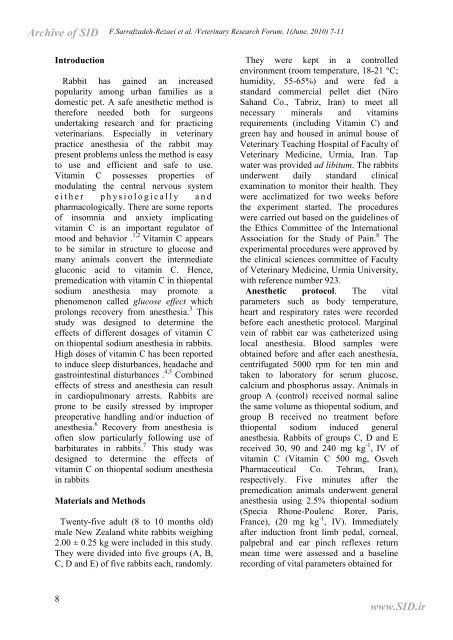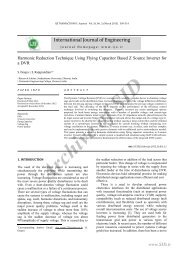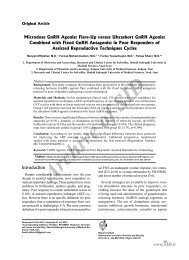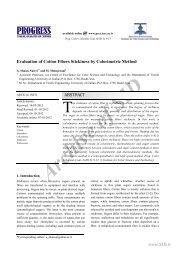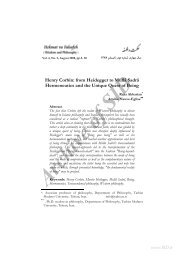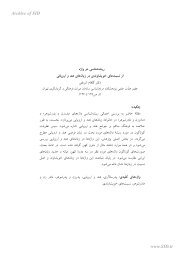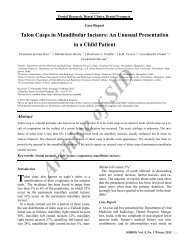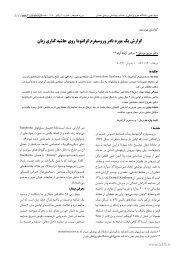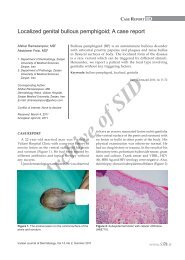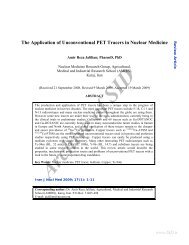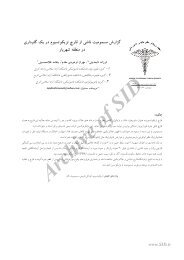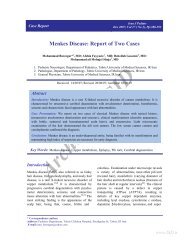thiopental sodium anesthesia following premedication of ... - Sid
thiopental sodium anesthesia following premedication of ... - Sid
thiopental sodium anesthesia following premedication of ... - Sid
You also want an ePaper? Increase the reach of your titles
YUMPU automatically turns print PDFs into web optimized ePapers that Google loves.
Archive <strong>of</strong> SID<br />
F.Sarrafzadeh-Rezaei et al. /Veterinary Research Forum. 1(June, 2010) 7-11<br />
Introduction<br />
Rabbit has gained an increased<br />
popularity among urban families as a<br />
domestic pet. A safe anesthetic method is<br />
therefore needed both for surgeons<br />
undertaking research and for practicing<br />
veterinarians. Especially in veterinary<br />
practice <strong>anesthesia</strong> <strong>of</strong> the rabbit may<br />
present problems unless the method is easy<br />
to use and efficient and safe to use.<br />
Vitamin C possesses properties <strong>of</strong><br />
modulating the central nervous system<br />
either physiologically and<br />
pharmacologically. There are some reports<br />
<strong>of</strong> insomnia and anxiety implicating<br />
vitamin C is an important regulator <strong>of</strong><br />
mood and behavior . 1,2 Vitamin C appears<br />
to be similar in structure to glucose and<br />
many animals convert the intermediate<br />
gluconic acid to vitamin C. Hence,<br />
<strong>premedication</strong> with vitamin C in <strong>thiopental</strong><br />
<strong>sodium</strong> <strong>anesthesia</strong> may promote a<br />
phenomenon called glucose effect which<br />
prolongs recovery from <strong>anesthesia</strong>. 3 This<br />
study was designed to determine the<br />
effects <strong>of</strong> different dosages <strong>of</strong> vitamin C<br />
on <strong>thiopental</strong> <strong>sodium</strong> <strong>anesthesia</strong> in rabbits.<br />
High doses <strong>of</strong> vitamin C has been reported<br />
to induce sleep disturbances, headache and<br />
gastrointestinal disturbances . 4,5 Combined<br />
effects <strong>of</strong> stress and <strong>anesthesia</strong> can result<br />
in cardiopulmonary arrests. Rabbits are<br />
prone to be easily stressed by improper<br />
preoperative handling and/or induction <strong>of</strong><br />
<strong>anesthesia</strong>. 6 Recovery from <strong>anesthesia</strong> is<br />
<strong>of</strong>ten slow particularly <strong>following</strong> use <strong>of</strong><br />
barbiturates in rabbits. 7 This study was<br />
designed to determine the effects <strong>of</strong><br />
vitamin C on <strong>thiopental</strong> <strong>sodium</strong> <strong>anesthesia</strong><br />
in rabbits<br />
Materials and Methods<br />
Twenty-five adult (8 to 10 months old)<br />
male New Zealand white rabbits weighing<br />
2.00 ± 0.25 kg were included in this study.<br />
They were divided into five groups (A, B,<br />
C, D and E) <strong>of</strong> five rabbits each, randomly.<br />
They were kept in a controlled<br />
environment (room temperature, 18-21 °C;<br />
humidity, 55-65%) and were fed a<br />
standard commercial pellet diet (Niro<br />
Sahand Co., Tabriz, Iran) to meet all<br />
necessary minerals and vitamins<br />
requirements (including Vitamin C) and<br />
green hay and housed in animal house <strong>of</strong><br />
Veterinary Teaching Hospital <strong>of</strong> Faculty <strong>of</strong><br />
Veterinary Medicine, Urmia, Iran. Tap<br />
water was provided ad libitum. The rabbits<br />
underwent daily standard clinical<br />
examination to monitor their health. They<br />
were acclimatized for two weeks before<br />
the experiment started. The procedures<br />
were carried out based on the guidelines <strong>of</strong><br />
the Ethics Committee <strong>of</strong> the International<br />
Association for the Study <strong>of</strong> Pain. 8 The<br />
experimental procedures were approved by<br />
the clinical sciences committee <strong>of</strong> Faculty<br />
<strong>of</strong> Veterinary Medicine, Urmia University,<br />
with reference number 923.<br />
Anesthetic protocol. The vital<br />
parameters such as body temperature,<br />
heart and respiratory rates were recorded<br />
before each anesthetic protocol. Marginal<br />
vein <strong>of</strong> rabbit ear was catheterized using<br />
local <strong>anesthesia</strong>. Blood samples were<br />
obtained before and after each <strong>anesthesia</strong>,<br />
centrifugated 5000 rpm for ten min and<br />
taken to laboratory for serum glucose,<br />
calcium and phosphorus assay. Animals in<br />
group A (control) received normal saline<br />
the same volume as <strong>thiopental</strong> <strong>sodium</strong>, and<br />
group B received no treatment before<br />
<strong>thiopental</strong> <strong>sodium</strong> induced general<br />
<strong>anesthesia</strong>. Rabbits <strong>of</strong> groups C, D and E<br />
received 30, 90 and 240 mg kg -1 , IV <strong>of</strong><br />
vitamin C (Vitamin C 500 mg, Osveh<br />
Pharmaceutical Co. Tehran, Iran),<br />
respectively. Five minutes after the<br />
<strong>premedication</strong> animals underwent general<br />
<strong>anesthesia</strong> using 2.5% <strong>thiopental</strong> <strong>sodium</strong><br />
(Specia Rhone-Poulenc Rorer, Paris,<br />
France), (20 mg kg -1 , IV). Immediately<br />
after induction front limb pedal, corneal,<br />
palpebral and ear pinch reflexes return<br />
mean time were assessed and a baseline<br />
recording <strong>of</strong> vital parameters obtained for<br />
8<br />
www.SID.ir


